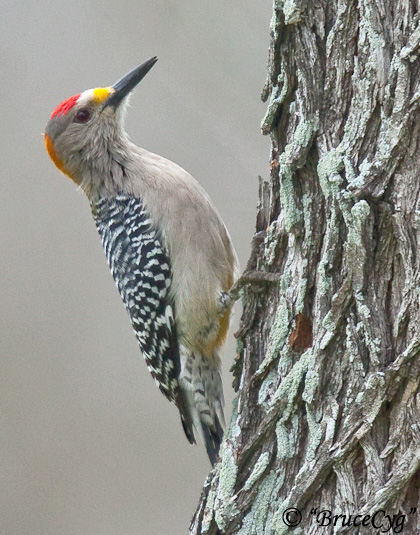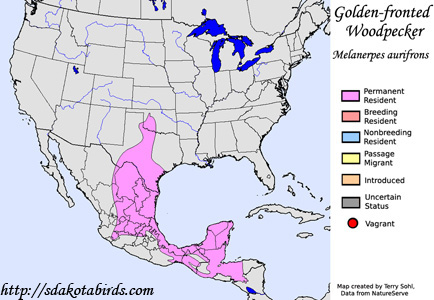| Length: 9.5 inches | Wingspan: 17 inches | Seasonality: Non-resident in South Dakota |
| ID Keys: Black-and-white barring on back, grayish underparts, orangish-yellow nape, white rump. Red crown on male. | ||
 The
Golden-fronted Woodpecker is a close relative of the
Red-bellied Woodpecker, with a
range that extends from Texas, southward into Mexico and Central America.
Golden-fronted Woodpeckers do occasionally interbreed with Red-bellied
Woodpeckers where their ranges meet in Texas. They are distinguished
in appearance by the golden color on their nape and above the bill.
Males and females are similar in appearance, except the male has a red
crown, while the female has a plain gray crown.
The
Golden-fronted Woodpecker is a close relative of the
Red-bellied Woodpecker, with a
range that extends from Texas, southward into Mexico and Central America.
Golden-fronted Woodpeckers do occasionally interbreed with Red-bellied
Woodpeckers where their ranges meet in Texas. They are distinguished
in appearance by the golden color on their nape and above the bill.
Males and females are similar in appearance, except the male has a red
crown, while the female has a plain gray crown.
Habitat: Found in open woodlands, particularly in riparian zones. Can be found in isolated groves of trees, and usually avoids dense unbroken forest.
Diet: Omnivorous, feeding on insects, spiders, fruits, berries, nuts, seeds, and a variety of other items.
Behavior: Uses a variety of foraging techniques. They will climb through the branches of trees looking for insects. They will also forage on the ground, and sometimes fly out to capture insects in mid-air.
Nesting: The nest of a Golden-fronted Woodpecker is a cavity in a tree, or sometimes in a man-made object like a utility pole or fence post. The female usually lays 4 or 5 eggs, with both parents helping to incubate them. When the eggs hatch, both parents help to feed the young. They often raise more than one brood per breeding season.
Song: The drumming of a Golden-fronted Woodpecker is short and of a moderate speed. The contact call is a grating Krrrr. Also has a series of other harsh calls.
Migration: Considered a permanent resident throughout its range. There are some short distance movements on occasion, with birds concentrating in areas with good foraging opportunities.
Interactive eBird Map: Click here to access an interactive eBird map of Golden-fronted Woodpecker sightings
Similar Species: Similar to Gila Woodpecker and Red-bellied Woodpecker, although Red-bellied is the only species potentially seen within its normal range.
Feeders: Will attend feeders for suet, nuts, and fruits.
Conservation Status: Populations of the Golden-fronted Woodpecker are stable, and the IUCN lists them as a species of "Least Concern".
Further Information: 1) Audubon Guide - Golden-fronted Woodpecker
2) USGS Patuxent Bird InfoCenter - Golden-fronted Woodpecker
3) WhatBird - Golden-fronted Woodpecker
Photo Information: Photo taken by "BruceCyg" - Choke Canyon State Park, Texas - Photo licensed under Creative Commons Attribution NonCommercial NoDerivs 2.0 Generic License.
| Click below for a higher-resolution map |
 |
| South Dakota Status: Non-resident in South Dakota |
Additional Golden-fronted Woodpecker Photos (coming soon!!)
